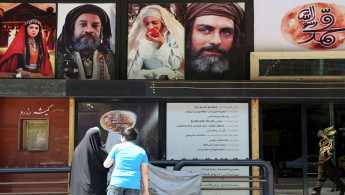A different perspective on 'Muhammad: The Messenger of God'
After allotting a record $40 million production budget, it seems that the Iranian producers of Muhammad: The Messenger of God are satisfied with their bet, as the movie that opened at the end of August is drawing in impressive audience figures.
The film was partially funded by the government and was widely promoted prior to its release, which explains much of its box office success. But the film's appeal has even reached Hollywood - being selected as the Iranian entry for Best Foreign Language Film at this year's Oscars.
| A young boy plays the film's central character, Muhammad, however his face never appears on screen |
Despite the controversy that surrounded the film, it raked in more than a million dollars in its first two weeks in Iran alone, with plans to distribute the film internationally.
In the 170-minute feature, director Majid Majidi depicts the life of Prophet Muhammad from birth until the age of 13.
A young boy plays the film's central character, Muhammad, however his face never appears on screen, despite his voice being heard in a number of scenes.
Majidi intends to create a number of sequels over the next few years that cover the remainder of the Prophet Muhammad's life.
A huge set was purpose built for the movie outside the Iranian capital Tehran, and some scenes were filmed in South Africa.
The film also employed Italian cinematographer Vittorio Storaro and Oscar-winning Indian composer AR Rahman on the score, decisions which attracted criticism from Iranian conservatives. But it is the best talent which must be used to help develop Iranian cinema, filmmakers argued.
The most severe criticism against the film came from the Arab world, especially from the grand imam of al-Azhar, Sheikh Ahmed al-Tayyeb, who railed against the depiction of the Prophet.
Within Iran, most criticism concerned the portrayal of certain historical incidents, with Majidi granting a number of scenes a legendary or mythical dimension.
Film critics welcomed Majidi's approach, differing as it does from traditional depictions of Islamic history due to its focus on the signs of Muhammad's prophethood and other characteristics that made the subject of the movie more appealing to viewers.
"The new filming techniques and the use of special effects have made the film stand out from other Iranian movies," said Jabbar Azin, an Iranian film critic.
"The focus on the Prophet's childhood makes the film different and better-suited to be marketed internationally," added Azin.
However, Azin also believes that Majidi's inability to portray the Prophet has created weaknesses in the dialogue in a number of scenes, and despite the use of special effects, some sequences could have looked more realistic.
| The movie is an attempt to bridge the two cultures and introduce the Prophet of Islam to the wider world |
The film's producer, Mohammed Mahdi Heidarian, meanwhile, believes that "having the film be different from other Islamic history movies is a positive thing, even though some people think that the effects don't fit with the story".
"The film is aimed at non-Muslims, and the cinematography was intentional, while making sure to portray events accurately," said Heidarian.
According to the film's producer, the budget was not very large and the filmmakers still expect it to bring in yet greater revenues when it is marketed internationally.
Heidarian spoke of the difficulties of gathering information about that specific period of the Prophet's life, which took the filmmakers two years.
"All that is available about that period does not exceed seven pages in the books of Islamic history, which is why we relied upon Jahili poetry to get to know the environment at the time, in addition to other verified sources to make this movie that was co-written by Sunni and Shia experts on Islamic history," said Heidarian.
Heidarian believes the criticism levelled against the film by Egypt's al-Azhar institution was based on preconceived notions - and because the film is Iranian.
Cinema should be viewed as an artistic platform able to convey a message, he said. Western culture heavily relies on pictorial depictions, while eastern culture relies on written depictions, Heidarian argued - and the movie is an attempt to bridge the two cultures and introduce the Prophet of Islam to the wider world.



![sudan women [getty] sudan women [getty]](/sites/default/files/styles/image_212x120/public/media/images/5019D7F4-52AF-4377-8A05-885D27476479.jpg?h=d1cb525d&itok=1Obcavax)